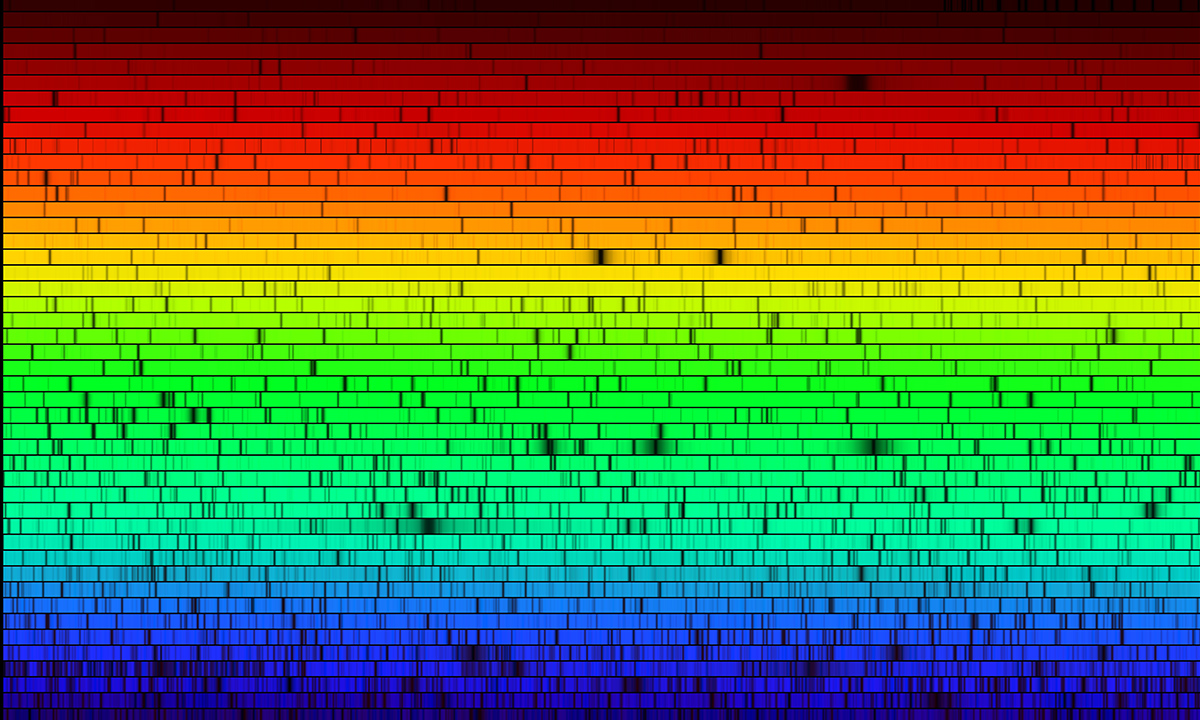
When the first exoplanets were discovered, astronomers were shocked to find gas giants like Jupiter but zipping around their host stars in days rather than years. These hot Jupiters orbited so close that astronomers worried they might eventually spiral into their stars. Although no one has yet seen a planet disappear, mounting circumstantial evidence suggests perhaps 35% of stars actually do consume their planetary children.
Talking on Sunshine
In the early 19th century, just about the time Wellington was queuing up to defeat Napoleon, a Bavarian glassmaker was studying strange shadows hidden in sunlight. The glassmaker, Joseph von Fraunhofer, found that, when he split the Sun’s light into its constituent rainbow of colors using a prism, dark lines appeared throughout. The origin of these “Fraunhofer lines” remained a mystery for more than 50 years when a new generation of German scientists realized chemical elements — hydrogen to radon — formed these lines by absorbing specific colors of light, providing a luminous fingerprint for identifying different elements. This was the beginning of the science of spectroscopy.

Today, astronomers use this technique from distant stars to figure out what distant stars are made of. Although the first correct estimates of stellar composition were not initially believed, we now know stars are made mostly of hydrogen and helium gas, with a dash of other heavier elements. There is some variation in composition (stars formed long ago have more hydrogen relative to iron, for example, than stars formed more recently), but this same pattern of mostly hydrogen and helium holds across the Universe.
Material World
This elemental melange reflects the composition of the giant molecular clouds that birthed the stars. These clouds, drifting through the galaxy like jellyfish, periodically collapse under their own weights. Stars coalesce like drops of rain in the clouds, gathering nearby gas and dust. Sometimes, multiple stars form together, joining in a graceful gravitational waltz and producing binary stars.

Since binary stars form from the same seed materials, their starting compositions are the same. The dust and gas leftover from the stars’ formation then goes into their planetary retinues. However, since the planet-forming processes differ from the star-forming ones, the planets’ compositions differ from the stars’. In particular, planets accrete more elements heavier than hydrogen and helium, like silicon and iron. And it’s this difference in composition that gives the telltale signs of planetary consumption.
Careless Sisters
If a star eats its planets, the planets’ rocks and metals will mix into the star’s atmosphere, slightly enriching the star in these heavier elements relative to the star’s original composition. Hotter stars have less churn in their atmospheres, and so consumed planetary materials remain near the top of their atmospheres, like driftwood on a calm ocean, making it easier to detect. Unfortunately, if that star is a singleton, astronomers would have no way to know about the enrichment because they wouldn’t know the original composition. But if the star has a binary companion that did NOT eat its planets, then spectroscopic comparison of their compositions would suggest to a planetary murder.
In a recent study, Lorenzo Spina of the Osservatorio Astronomico di Padova (the Italian city where Galileo started out) reported a compositional analysis of binary stars. They found that perhaps 35% of binaries host one companion with a distinct enrichment in planet-forming materials. More than that, the enrichment signature is more pronounced for hotter stars, exactly as expected. Modeling of the enrichment signatures suggests stars that do eat planets eat between 1 and 10 Earth’s worth. How exactly these planets were consumed is unclear, but decades of exoplanet modeling has suggested that planetary systems often enter a period of dynamical chaos, as neighboring planets gravitationally jostle one another early in their histories. This sisterly conflict could easily toss one or more planets into the plasmaspheric maw of the host star.
How did our Solar System avoid such destruction? Well, who said we did? The Sun is currently a singleton star, so we don’t have any companion stars to compare its composition to. But studies going back about a decade have shown the Sun has an unusual and still unexplained chemical composition compared to other similar stars. Models of the early Solar System have suggested again and again that we may also have experienced these same kinds of dynamical growing pains inferred for other solar systems. So, far from the gentle, life-giving host we know today, the Sun may actually be an unrepentant murderer.
Hugh Aldersey-Williams tells the story of Fraunhofer’s lines and the discovery of the elements in his energetic and wide-ranging book Periodic Tales: A Cultural History of the Elements, from Arsenic to Zinc.
We discussed this paper in our astronomy research group meeting on 2021 Sep 10 using these summary notes.